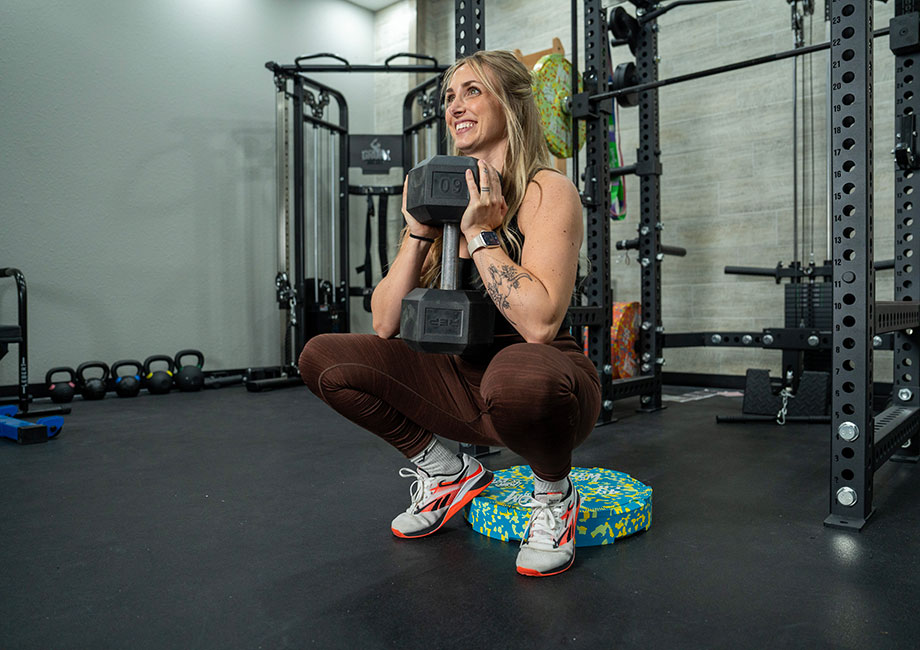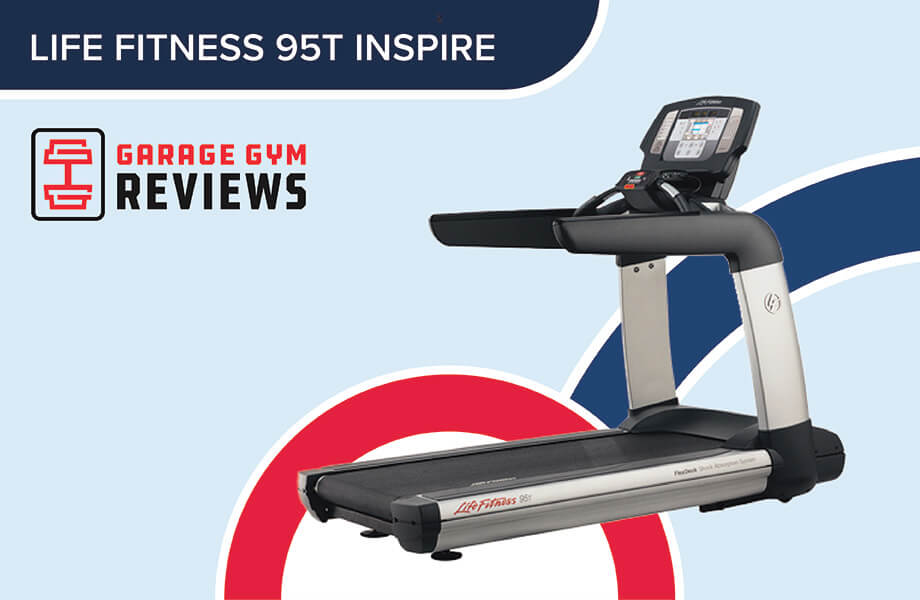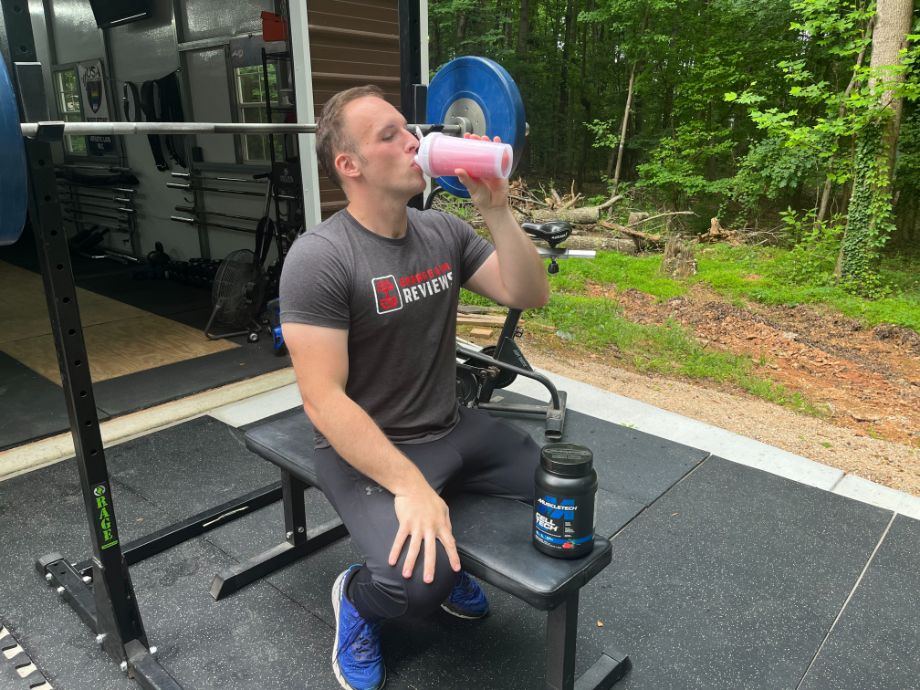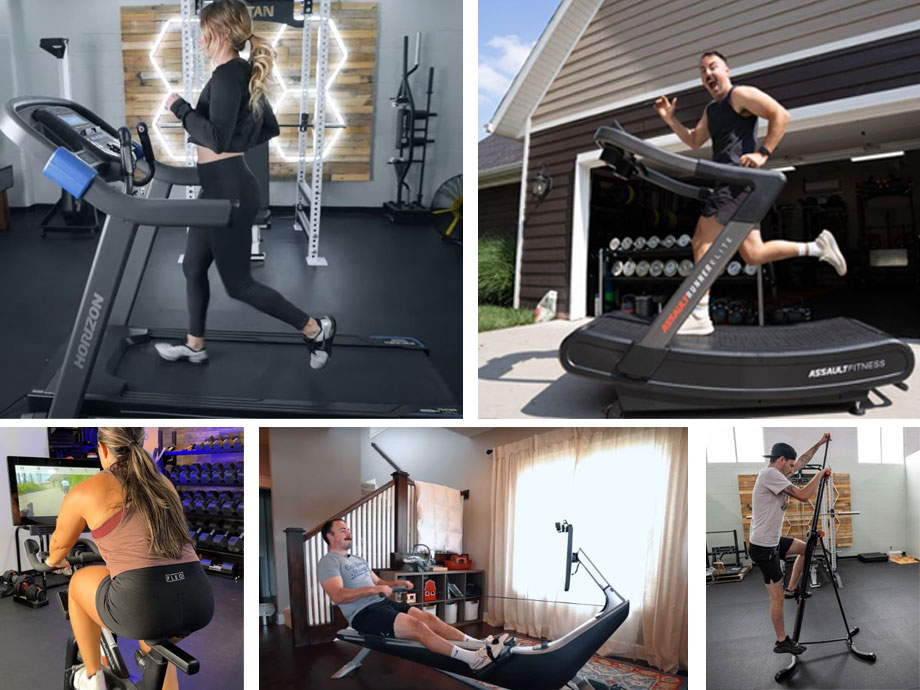Few moves are as ubiquitous as the classic squat exercise when putting together a great leg day workout routine. Squats aren’t just for powerlifting/bodybuilding; they’re highly functional, improve lower-body strength, build muscle, and translate nicely to enhanced sports performance.
Today, we’re focusing on a squat variation that makes one minor adjustment to your form for you to reap major rewards. It’s called the heel-elevated goblet squat, and as the name suggests, it involves elevating your heels to enable a deeper squat, maximize your range of motion, improve postural stability, and reduce stress on your knees.
Caine Wilkes, OLY, USAW-L1, and GGR senior staff writer, weighs in on the heel-elevated goblet squat, sharing a step-by-step tutorial for proper form, modifications, benefits, and more.
RELATED: How To Squat Heavier
How To Do the Heel-Elevated Goblet Squat
“You don’t need much elevation to get into the proper position,” says Caine. “Wearing a pair of the best weightlifting shoes is a great way to get a little heel elevation, but you can also use heel wedges, a slant board, or even a pair of light weight plates.”
How to do it:
- Select your dumbbell or kettlebell and hold it in front of your chest in the goblet position.
- Stand with your feet shoulder-width apart and your heels elevated using a heel wedge, slant board, bumper plates, or by wearing specialized weightlifting shoes.
- Brace your core, push your hips back, and squat by bending your knees.
- Continue until your knees are nearly fully flexed.
- Pause, then drive through your heels to stand back up until your hips reach full extension.
- Squeeze your glutes, then cycle into the next rep.
- Repeat the movement for your desired number of repetitions.
RELATED: Best Slant Boards
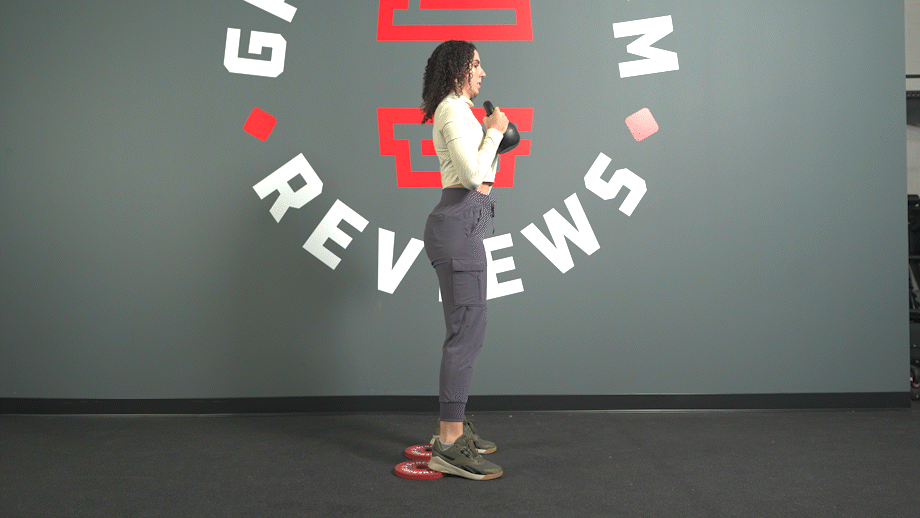
Modifications
- Dial it back: Use light weights, no weights, or do regular goblet squats instead.
- Make it harder: Use heavy weights or attempt a heel-elevated barbell front squat.
How To Do the Heel-Elevated Goblet Squat At Home
Use a heavy household object (a jug of laundry detergent, for example) as your free weight. Find something sturdy to wedge under your heels—and make sure it doesn’t slide out from under you!)
Heel-Elevated Goblet Squat Variations
You can use progressively heavier free weights as you gain proficiency with your heel-elevated goblet squats, but there are also a few variations you can use to keep the gains gaining.
- Heel-elevated front squat: Trading your dumbbell or kettlebell for a barbell requires greater shoulder and wrist mobility and allows you to lift heavier.
- Heel-elevated back squat: Most lifters find back squats easier than front squats, enabling them to move even more weight. This variation provides increased activation to the quadriceps and translates to improved back squat performance with the heels down.
- Heel-elevated Zercher squat: Zercher squats involve holding that heavy barbell with the creases of your elbows, making it awkward and possibly painful if you’re not used to that. It’s worth it, though, because this one really hits your core and quads hard!
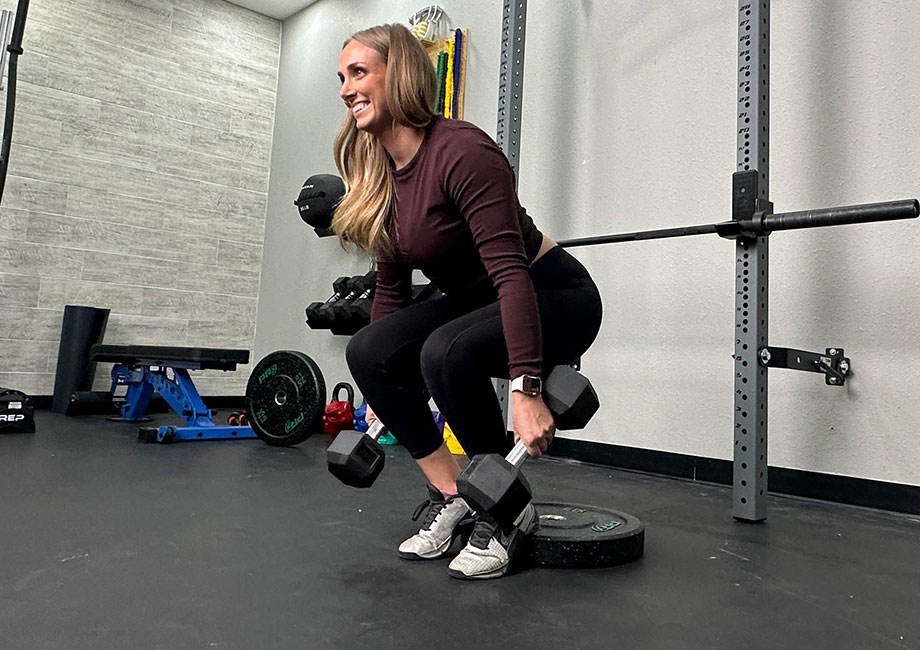
Heel-Elevated Goblet Squat Alternatives
You can really up the ante on your workouts by adding the heel-elevated goblet squat to your programming, but it’s far from the only lower-body exercise for your training arsenal.
Try out some of these bad boys during your next leg day workout!
Single-Leg Leg Press
Why do it: “The leg press makes a great alternative to your standard squat movement since the movement pattern is so similar,” says Caine Wilkes, OLY, USAW-L1, “but performing the leg press with one leg at a time gives you a lot of control over the loading and helps correct muscle imbalances.”
How to do it:
- Adjust the leg press machine to your specifications, set it to your desired weight, and sit down with your back firmly pressed against the pad and your hands around the handles.
- Place both feet on the leg press platform, keeping a slight bend in your knees, and release the safety catch.
- Remove one foot from the platform.
- Slowly bend your working knee until it forms a 90-degree angle.
- Pause, then push the platform back to the starting position.
- Repeat for reps, then switch legs and repeat the set.
RELATED: Unilateral Exercises
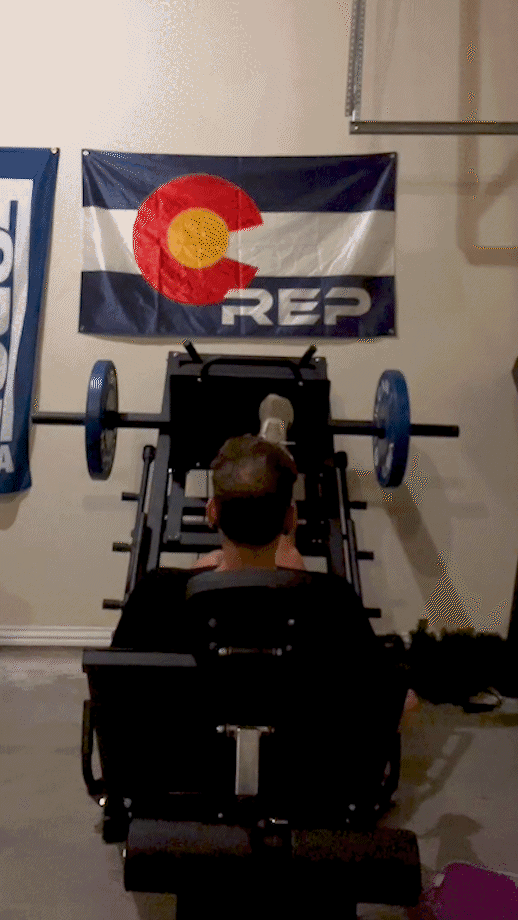
Leg Extension
Why do it: Few lower body exercises isolate the quadriceps as intensely as the leg extension. According to the Journal of Sports Sciences1, the leg extension exercise may provide superior quadriceps hypertrophy compared to the squat. You can further isolate this movement by working one leg at a time.
How to do it:
- Adjust the leg extension machine to your specifications, set it to your desired weight, and sit down with your back firmly pressed against the pad and your hands around the handles.
- Position your shins so they’re against the pad and slowly straighten your legs.
- Continue until your knees are fully extended.
- Squeeze your quads, then slowly return to the starting position.
- Repeat for reps.
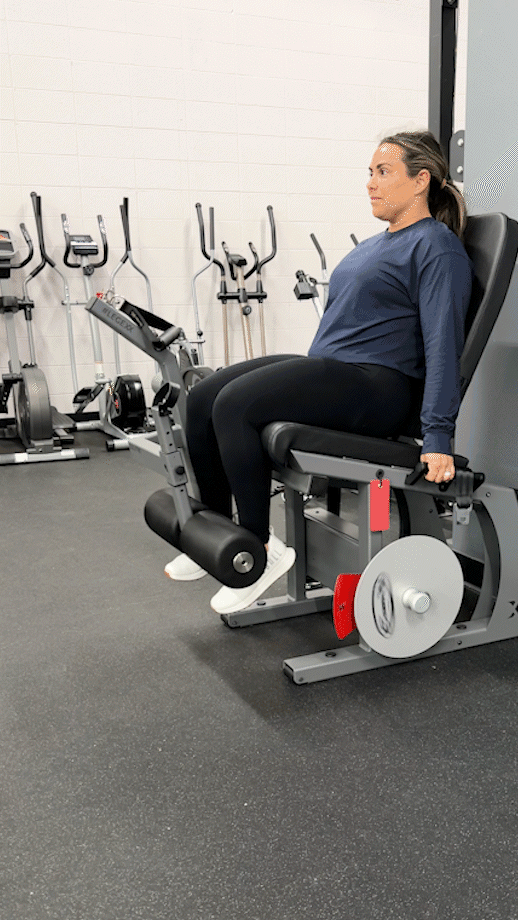
Dumbbell Squat
Why do it: “Dumbbells let you take your squats to the next level by adding resistance,” explains Caine. “Plus, there are many different ways of holding them, including the goblet grip, suitcase grip, and front rack position, which help you further vary the stimulus to the target muscles.”
How to do it:
- Grab a pair of the best dumbbells and stand with your feet shoulder-width apart. You may hold them at your sides like suitcases or hoist them into the front rack position.
- Brace your core, push your hips back, and squat by bending your knees.
- Continue until your thighs are nearly parallel with the floor.
- Pause, then drive through your heels to stand back up.
- Continue until your hips reach full extension and squeeze your glutes.
- Repeat for reps.
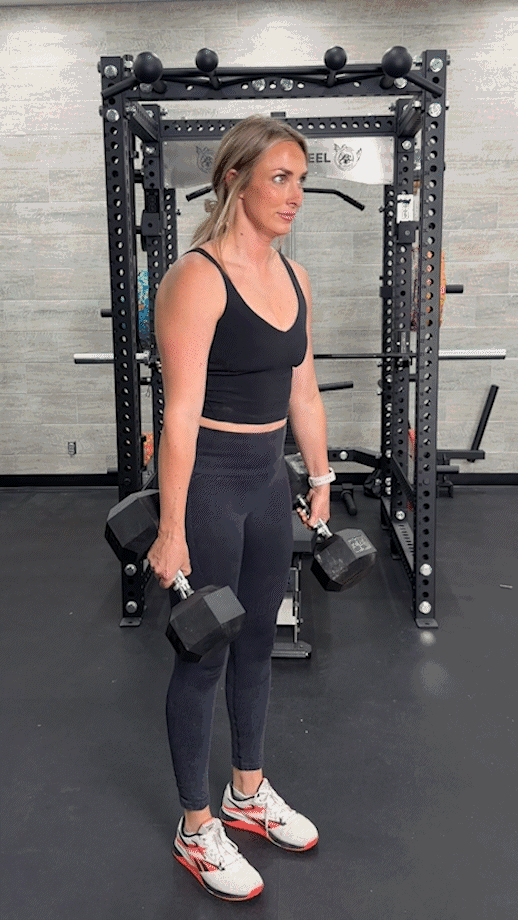
Cyclist Squat
Why do it: Heel-elevated goblet squats, and heel-elevated squats in general, incorporate heel elevation to enable a wider range of motion and deeper squat. Cyclist squats take that concept one step further by increasing the height of your heel wedge.
How to do it:
- Set up a steep heel wedge (approximately one inch or greater) inside of a squat rack or Smith machine and stand on it.
- Brace your core, push your hips back, and squat with a barbell resting across your upper back by bending your knees.
- Continue until your knees are nearly fully flexed.
- Pause, then drive through your heels to stand back up.
- Continue until your hips reach full extension and squeeze your glutes.
- Repeat for reps.
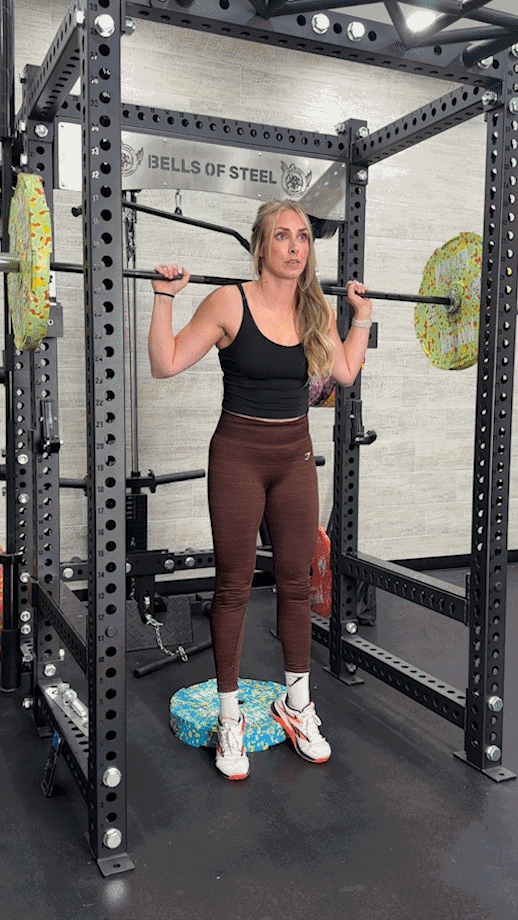
Benefits of the Heel-Elevated Goblet Squat
The squat already ranks as one of the best exercises you can be doing in the gym in the first place, so what benefits does elevating your heels offer?
Increases Muscle Activation
According to Bioengineering (Basel)2, elevating the heel while squatting results in “a significant increase in activation of the vastus lateralis, biceps femoris, and gastrocnemius muscles.”
That would be the quadriceps, hamstrings, and calf muscles, respectively, meaning you may be able to develop these muscle groups in less time, thanks to the increased muscle activation.
May Be Easier on Your Knees and Lower Back
According to the Journal of Sports Sciences3, lifters tend to lean forward less during front squats and front squat variations, like the goblet squat, suggesting that they “may be preferred to the back squat for knee extensor development and for preventing possible lumbar injuries during maximum loading.”
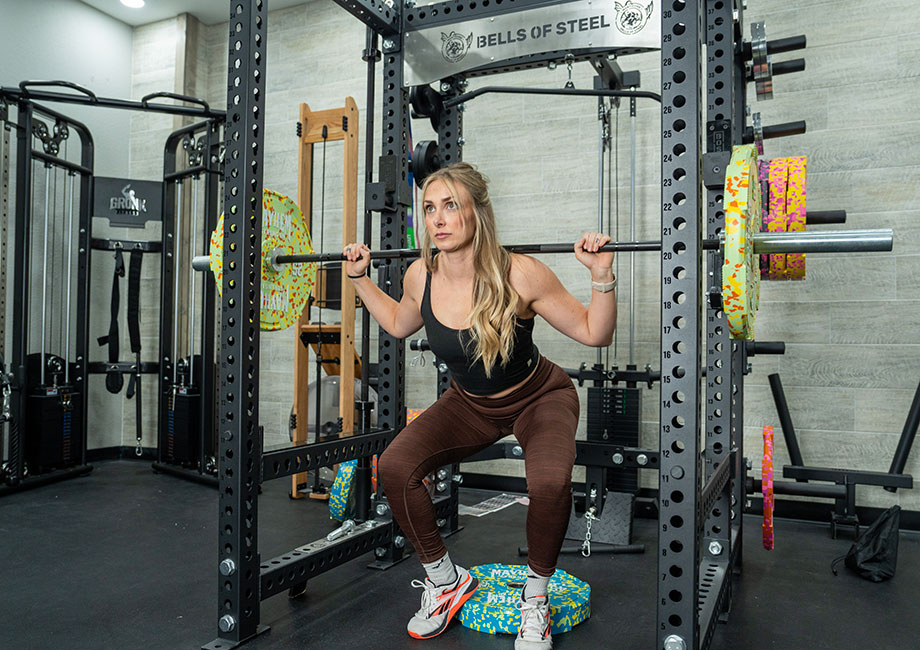
So, if you’re prone to knee or low back pain, you may find the positioning of the front squat, goblet squat, and heel-elevated goblet squat more comfortable.
May Help Improve Ankle Flexibility
“Beginners may struggle to get a nice, deep squat due to ankle mobility issues,” says Caine Wilkes, OLY, USAW-L1. “You can address these issues by adding ankle mobility exercises into your regular workout routine, but that can take time. Elevating the heel provides a solution for the short term.”
According to BMC Sports Science, Medicine, and Rehabilitation4, “using wedges or weightlifting shoes to elevate the heels” while squatting is a “common approach to address ankle mobility issues.”
The elevated heel alters lower limb kinematics (or motion) to enable a deeper squat and, over time, may increase ankle flexibility to allow for deeper squats, even with regular foot positioning.
Common Heel-Elevated Goblet Squat Mistakes
You can get the technique for the heel-elevated goblet squat down pat if you practice with proper form. Watch out for the following common form mistakes.
Rounding Your Back
The heel-elevated goblet squat is predominantly a lower-body exercise, but that doesn’t mean you can neglect your upper body. A strong, upright posture protects you from some nasty injuries, allowing you to move most efficiently and produce the most power during the eccentric phase of the movement.
“Rounding your back can happen when you’re not holding enough tension in your torso,” says Caine. “Often, it’s an indication that you’re using weights that are too heavy or need to work more on core strength to hold good posture.”
To correct, reduce the weight of your dumbbell or kettlebell, brace your core, and try again.
Working with a certified personal trainer or strength coach may help if you’re having trouble maintaining a straight back when performing this exercise.
RELATED: Best Online Personal Trainer
Improper Foot Positioning
The exercise is called the heel-elevated goblet squat, the operative word being heel. As the name suggests, you want your heels raised about a half-inch off the floor by using wedges, weight plates, or weightlifting shoes.
What you don’t want is your whole foot elevated or slanted. This positioning compromises your balance and lower-body kinematics, making it harder to move weight efficiently and safely.

So, if you’re using heel wedges, weight plates, or a slant board, only elevate your heels and firmly plant the front of your foot on the floor. On the other hand (or foot, so to speak), if you’re using weightlifting shoes, they’ll do that part of the job for you.
Not Using a Full Range of Motion
“Elevating your heels should allow for a wider range of motion due to the improved ankle flexibility,” says Caine, “but you still have to work to squat deep enough to benefit from that.”
You’ll defeat the purpose of elevating your heels if you’re doing half-squats. Make sure you go all the way down past the point where your thighs are parallel to the floor, pause, and then shoot back up by driving through your heels.
Don’t shortchange yourself at the top of the movement, either. Squeeze your glutes and bring your hips forward to full extension before you cycle into the next rep. You’ll get the most bang for your buck this way.
RELATED: Gluteus Maximus Exercises
Muscles Worked by the Heel-Elevated Goblet Squat
As a compound exercise, the heel-elevated goblet squat hits muscles in your lower body, upper body, and core. The most critical muscles involved include:
- Quadriceps: The quads control knee extension, meaning you’ll really need them to help drive that weight back up out of the bottom of your squat. They also assist hip flexion, meaning they help during the concentric phase of the exercise.
- Glutes: Your glutes are heavily involved in hip movements, including extension and flexion. That means you’ll need them as you flex your hips on the way down, and you’ll need them again as you come back up and eventually reach full hip extension.
- Core: Holding a heavy weight in front of your body requires strong core muscles to stabilize your torso and maintain good posture.
- Upper body: Holding that heavy weight also requires strong arms, lats, traps, and rhomboids, so your lower half won’t get all the muscle activation during this one.
RELATED: What Muscles Do Squats Work?
Heel-Elevated Goblet Squat: Final Thoughts
The standard squat exercise is the cornerstone in many strength training programs, but doing the same version of this tried-and-true exercise is monotonous. That’s why it’s important to spice up your routine with squat variations like the heel-elevated goblet squat.
RELATED: Benefits of Strength Training
Not only does this movement help stave off boredom and prevent plateauing, but elevating the heels helps beginners and seasoned weightlifters alike address ankle mobility issues by enabling a greater range of motion and deeper squats. They’ll allow for greater muscle activation to your quads, glutes, hamstrings, and other lower-body muscles, making them integral to a well-rounded workout.
So, what are you waiting for? Give them a try during your next leg day!
Heel-Elevated Goblet Squat: FAQs
Are elevated heel squats good or bad?
“Critics claim that heel-elevated squats may reinforce bad habits because the positioning eliminates ankle dorsiflexion. They’re not entirely wrong, but that doesn’t mean you should completely avoid this movement,” says Caine Wilkes, OLY, USAW-L1, and GGR senior staff writer. “Heel-elevated squats provide a more comfortable way for individuals with ankle flexibility issues to squat, which is good.” That said, still address those ankle mobility issues with lower-body exercises like lunges, bodyweight squats, and Bulgarian split squats.
Adopting a multifaceted approach can allow you to reap the rewards associated with heel-elevated goblet squats while improving ankle mobility.
What’s the difference between an elevated goblet squat and a front squat?
Goblet and front squats are similar since both exercises involve holding a free weight in front of your body. The key difference is how you hold the weight.
The goblet squat uses both arms to hold the weight at chest height in front of the body’s midline, whereas the front squat places the weight or weights in the front rack position at approximately shoulder height. This requires more shoulder and wrist mobility from the lifter, making it the harder of the two movements.
What’s the purpose of heel elevated squats?
Elevating your heels during the squat exercise allows a lifter to work around ankle mobility issues and get a greater range of motion. Additionally, the change in positioning may result in greater muscle activation in various lower body muscles, making it a highly effective exercise.
References
1. Zabaleta-Korta A, Fernández-Peña E, Torres-Unda J, Garbisu-Hualde A, Santos-Concejero J. The role of exercise selection in regional Muscle Hypertrophy: A randomized controlled trial. J Sports Sci. 2021;39(20):2298-2304. doi:10.1080/02640414.2021.1929736
2. Lu Z, Li X, Xuan R, et al. Effect of Heel Lift Insoles on Lower Extremity Muscle Activation and Joint Work during Barbell Squats. Bioengineering (Basel). 2022;9(7):301. Published 2022 Jul 8. doi:10.3390/bioengineering9070301
3. Yavuz HU, Erdağ D, Amca AM, Aritan S. Kinematic and EMG activities during front and back squat variations in maximum loads. J Sports Sci. 2015;33(10):1058-1066. doi:10.1080/02640414.2014.984240
4. Sayers MGL, Hosseini Nasab SH, Bachem C, Taylor WR, List R, Lorenzetti S. The effect of increasing heel height on lower limb symmetry during the back squat in trained and novice lifters. BMC Sports Sci Med Rehabil. 2020;12:42. Published 2020 Jul 25. doi:10.1186/s13102-020-00191-y


